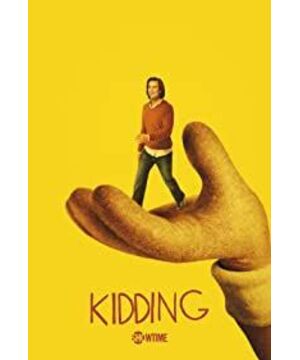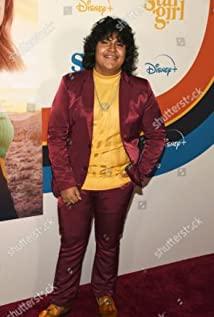By Lacey Rose (The Hollywood Reporter)
Translator: csh
The translation was first published in "Iris"
Editor's note: After so many years, there is finally a detailed biography that tells the story of the movie star who used to be paid $20 million and is now a political cartoonist. He's finally beginning to explain his disappearance, his private pain, his anger, and why he's back on the screen with Showtime's "Just kidding" (2018). Jim Carrey "Not to join Hollywood, but to destroy Hollywood."
Jim Carrey is so tired. His eyelids were heavy and exhausted, he hadn't been so tired in years.
It was just past ten o'clock at night. Away from the Santa Anita Botanical Gardens in Pasanadi (California, USA). Carey is very involved. He tucked his shaggy hair behind his ears, wiped the sweat from his forehead, and began another four-and-a-half-minute monologue. However, he had no time to memorize his lines. If all goes well, he can pack up and go home at midnight. But in the television world, four and a half minutes means eternity, the opposite of "everything goes well." In the scorching light, Carrey could barely see the teleprompter and kept getting stuck during monologues.
"Shit," he muttered. This is his third, or fourth, remake.
He kept mumbling.
"Shit, shit, shit."
He desperately wanted to keep shooting, but the photographer needed to refill the memory card. All are waiting. Extras and other crew members were afraid to speak out. For a few minutes, everything seemed to freeze. After reloading, Carey reshot a shot. Then another shot. He punched hard. His eyes were swollen. He was controlling his frustration, and he seemed to succeed. His longtime partner, Michel Gondry (with whom he first collaborated on 2004's "The Light Within") is finally relaxing in the director's chair. This was the Jim Carrey he remembered.
And the rest of Hollywood remembers Jim Carrey as the man who made $20 million a movie—he was like a shooting star, first on Fox's TV show Vivid Colors (1990) It was a smash hit, and it went on to become a box-office superstar, with a quick succession of hits: "The Detective" (1994), "Grangers in Disguise" (1994), "Dumb and Dumber" (1994). The movie industry took great pains to sign him one huge check after another; however, it was Jim Carrey himself who didn't bother to exchange those bills. There is no "turning point" and no "downfall". He simply did less and less filming, until in the end, he really stopped filming at all. And when he felt it was time for a comeback, there was Joke (2018), in which he played Jeff Pickles, a Mister Rogers-esque children's show icon. The character struggles to maintain his suave, tall, sane public image, while his private life slides into hell. When the work premieres on Sept. 9, among other topics, it will raise questions about public life that are bound to touch the sore spot of Jim Carrey, a disgraced man.
"I just don't want to get involved with those businesses anymore," Jim Carrey said the next day. At that time, I stayed with him in the living room of his house. He lives alone in the ranch-style house in Brentwood. He bought the house 23 years ago with the money he earned from Dumb and Dumber (1994). Today, as he embarks on his second life as a visual artist, it's a shrine to his paintings, drawings and sculptures. "I don't like what's going on right now, companies accepting everything, that sort of thing. Probably also because I'm attracted to another way of creating things, I really like the sense of control of painting - you don't have to obey anything Commission, listen to someone else's orders, and everything must be done according to some four-quadrant rule."
During the 2016 election, Carey honed his craft as a political cartoonist. And on his Twitter account, he delighted his 18 million followers with a series of caricatures slamming Donald Trump. Staying at home, using a sketchbook, and a basket of acrylic markers, he created the antidote that feeds the entertainment industry. Even if his writings haven't been answered by the president or "sociopaths" in the White House, they do bring Carey back into the public eye and rejuvenate him. Following the necessary entreaties of Dave Holstein, the creator of Joke (whom Mr. Pickles was a natural actor in his conception) and entertainment time bosses, Carrey decided to take part in the most important film and television show of recent years. project.
Right now, we sit here, surrounded by his artwork, which embodies his genius. And the 56-year-old actor, who seemed to sense something, warned me against adopting that "forced" comeback narrative. He spoke softly, but his tone was unusually firm. "I didn't come back that way," he said. "I didn't feel like a naive, desperately trying to grab something on the top -- I didn't feel like I wanted to grab anything."
Jim Carrey's social network accounts are now almost dominated by his political art, and although he has no way to log into his own, he has to have more than three people for almost every blog post ("just friends," he says ) signed consent. "You do need some cushion when you're in my position," he told me. His friend Dana Vachon (who is collaborating on a classified book) sees Carrey's work as a form of protest art, though Carrey himself believes he can't just let the nightmare happen: "I watch this When I’m in the world, I see things that make me uncomfortable, and I have to put them into art.” He often found himself painting late.
Jim Carrey is working on his next move, and he's decided to get more involved offline. But he wasn't quite sure what he should do. He got calls asking him to do something for some candidates, or to use his fame to build momentum, as many big stars have done. But he said he made an informed decision. "I try to avoid the hillsides around, the fundraising teams that Hillary sends," he said, "but I have to support the local guys and make sure (House Majority Leader) Kevin McCarthy doesn't come back. I Gotta get (Member of the House) Devin Nunes to never get involved in this thing again. Terry Gaudi and Jim Jordan? I mean, man, these fuckers are still getting together. It's not at all It's just one pile of trash supporting another pile of trash."
He looks like he's fighting, the most dynamic Jim Carrey I've ever seen.
He could chat for hours on political topics, but Carey would also love to show off his art. So I followed him through the corridors of the house with the tape recorder.
Vaschan had half-jokingly called Kerry's house a "Buddhist temple," but I don't think Kerry lined every wall with his colorful paintings the last time he was there. I remember seeing at least two dozen paintings: a figure of Christ with people of different races at the door (“I wanted to capture the consciousness of Jesus penetrating the sky”); a portrait of Lindsay Lohan, who was seated On his breakfast table, he prepared for the 2011 trial (“I can’t forget the way she went to the trial in fancy clothes”; translator: Hollywood actress Lindsay Lohan in 2011 He was remanded in custody for violating his 2007 probation for drunk driving in a jewelry store theft of a necklace); Germany", a re-creation of that infamous death scene.
A luna statue in the middle of his courtyard caught my attention. Her name, he told me, was Ella, and it took him two years to complete the sculpture at his foundry in Los Angeles. He swore to me that when the full moon reflected on her eyelids, she would open her eyes, "like she woke up," he said excitedly. It led me to a sculpture that looked like a religious symbol. It was a huge letter "T" with an "I" inscribed in it. This sculpture confuses me a bit.
"As always, I didn't know why I wanted to carve this thing at first. After a year or two, I woke up and realized that I got a straight answer from this sculpture." He said, " I'm on the road to my own identity, asking who I really am, and that's what this sculpture is about. This is the answer. If there is such a being (it) in this world, it means "Who am I? , which doesn't have an "I" in it, but has the shape of an "I" in it. Do you see what I mean? "At that moment, I wish I knew what he meant.
(Translator's note: According to Carey, this sculpture of his should be a symbol of the pursuit of self-identity. Because "IT" can be understood as "identity", which is the abbreviation of "identity". He used the word "identity" in the word "identity". The existing word "I", the word for "I" in English, also makes use of the letter "I" hidden in the letter "T".)
In fact, Carey's existential journey began in his childhood bedroom in suburban Toronto. At the time, he was obsessed with writing poetry, delving into what he thought was philosophy at the time. "I'm just trying to figure out what we are and why we're here," he shrugged. "It's all old questions."
If he's not thinking about philosophy, he's preparing a show for himself the next time he has a guest at home. By the time he was nine or ten, Carrey had performed a hundred and twenty "parody shows." To win a louder laugh, he would always do something exaggerated, like sliding down the stairs. “My parents saw my comedy acting as something special—in a way, I was special to them,” he said. His three sisters are also very supportive of this. "I've actually always been from another planet. There's nothing like the me they like and support. They'll just say: Hey, get Kim out of the room."
Initially, Kerry did like to be noticed. But over time, these comedy acts became just to keep his parents happy.
"Most of the time, my mother wasn't in good health," he said when we first brought up the topic. Later, for no apparent reason, he returned to the subject, "She's a little addicted to painkillers. She's often very ill with a variety of causes. She's cute, yes, but she's an alcoholic and doesn't drink well. She doesn't mean to indulge - she's always there with me, she's always in the house - but if you're addicted to painkillers, you can't control yourself. I think we're all addicted to something, most of us People become addicted to certain things, or certain people. It becomes a belief within us.”
By the time Carrey first moved to Los Angeles in the early 1980s, he had already built some television fame with the NBC sitcom "The Duck Factory." However, it was when it came to "Vivid Colors" that he really became a star. The comedy's cast also includes Jamie Foxx and several Wayans. s, Kieren Avery Wayans, Kim Wayans, etc., really a lot of Wayans...). In Vivid Colors, Carrey became a fan favorite by playing a whole bunch of quirky characters. These characters include Fire Chief Bill, who keeps blowing himself up. When he came home at night, he started to finish the work of "Detective Plane Head". For those of Carrey's 1994 films, the mission was simple: make fun of the leading men. "My plan was not to join Hollywood, but to destroy it," he said. "It's like taking a sledgehammer and smashing those leading men to death, smashing all the serious stuff." His colleagues in Vivid Colors sometimes mocked him. "David Alan Greer would walk up to the audience and say, 'He's gotta get to work on a movie called 'The Detective' while Kim is resting, and let's wish him luck. Individuals would see me as a laughing stock - they would pretend to applaud and laugh at me."
Carrey was performing stand-up comedy in Chicago a few days before the release of Detective Plane. His manager took him to dinner, and then surreptitiously told him: Siskel and Ebert, two of the most influential film critics, hated the film. "I mean, they really hated that movie," he said. Then the movie came out and made over $100 million. Overnight, Kerry became a big name. After a perfect negotiation, he was paid $450,000 for "Grange in Disguise," followed by $7 million for "Dumb and Dumber." By the time "The Correspondent" was filmed, Carrey was the highest-paid movie star—and certainly one of the most recognizable.
His new life is truly colorful: famous girlfriends (Renée Zellweger and Janney McCarthy), expensive cars, a helicopter leased by the crew, transporting him to and from remote locations (of course , including Santa Anita). But the fame also had unforeseen psychological effects on him: "It's like weightlessness," he says. "When you want something, you can dream. But when you really get everything, And you realize, you can't enjoy it for long."
For a long time, Carey never stopped. He's been taking on the show, filming film after film.
Among them, "Man on the Moon" in 1999 is his most devoted work. In those extra-long shots, Carrey literally embodies himself as the late entertainer Andy Kaufman, and Kaufman's vulgar alter-ego, Tony Kerry. Last year, a behind-the-scenes look at the famous film was the subject of a Netflix documentary, Jim Carrey and Andy Kaufman: Beyond Greatness. In the documentary, Carrey mentions that the "Man on the Moon" executives, known as Universal, tried to bury the film in order to preserve his on-screen image. "That way people don't think Kim is an asshole," Carrey said from a third-person perspective.
A few years after The Man on the Moon, Carey met Gondry while he was healing a relationship (that time period seems to refer to Zellweger, though Carey declined to name). Gondry saw an opportunity to turn that pain into art. "Oh, he seems to think my pain is beautiful," Kerry now laughs. "We had to wait until the second year to make 'The Light Within.' Then he said (Kerry imitating Gondry's heavy French accent): Please keep the pain." 2003) to visit Carrey. Carey was filming a "heavy taste" scene on the stairs, but Gondry was more interested in what happened during the break. "Kim was going to play, and I noticed the loneliness inside him," he said. "I told myself I had to film this loneliness."
"The Light Within" does deliver one of Carrey's most stunning performances, showing him as a theatrical actor rather than a comedian. The characters he chose have undoubtedly gotten darker and spookier over time, including the character in Anna Lily Amipur's dystopian "Bad Love" (2016). In that film, he didn't say a single line. The 2016 role was born out of a meeting between Michael Aguiler (Carrey's production partner) a few years ago with a series of filmmakers. "Actually, he was introduced to some young filmmakers, like the Duplass brothers, and now the world really belongs to them. They will say: We made movies because of you, but we can give you something different. idea, something we haven't seen you do," Aguiler said, "and that's what excites Kim."
When Aguiler read the draft script for "Joke," he guessed, it's something that's going to catch Carey's attention as well. "It's a story about an icon who has a big public image and he doesn't feel like he has anything to do with that," Aguiler said. Tell him: No, you can't do it. Uh, I said, isn't that just Kim?" Entertainment Time CEO David Nevins quickly spotted the possibility of Carrey taking the role. "I like the idea, because Jeff Pickles' characters cover that carefree, sloppy, much-loved Jim Carrey, from 'Dumbo' to 'Dumb & Duck,'" the text said. "But it also covers that serious, deep, Jim Carrey in 'Warm and Light,'" says St.
"You're always waiting for a character that you can consider a part of your life," Carrey said. "It's this moment where the experiences of life come together. I was a complete failure, and now I'm inexplicably standing. The opposite of failure allows me to look down on all of them, as if I share the same breath and destiny with each of them. I know how the current of grief can pull you at a certain stage in your life and break you down with ease. "
In a few days, he'll wrap up filming the first season of "Just kidding," cut off that shaggy hair, and head to Vancouver. There, he'll play a major villain in "Sonic the Hedgehog," his first major studio film in recent years. I wonder if Carrey would feel obligated to return to those blockbusters that entertain millions of viewers. His answer was firm: "No," and he would never be swayed by the market.
"I do hear some voices, though," he told me. "I hear people saying: Why can't he be a good comedian? Questions like that never bother me. Say, it's like... an experiment tonight. If you enjoy it, of course it's fine, if you don't, it's okay. There's something different tomorrow."
View more about Kidding reviews











